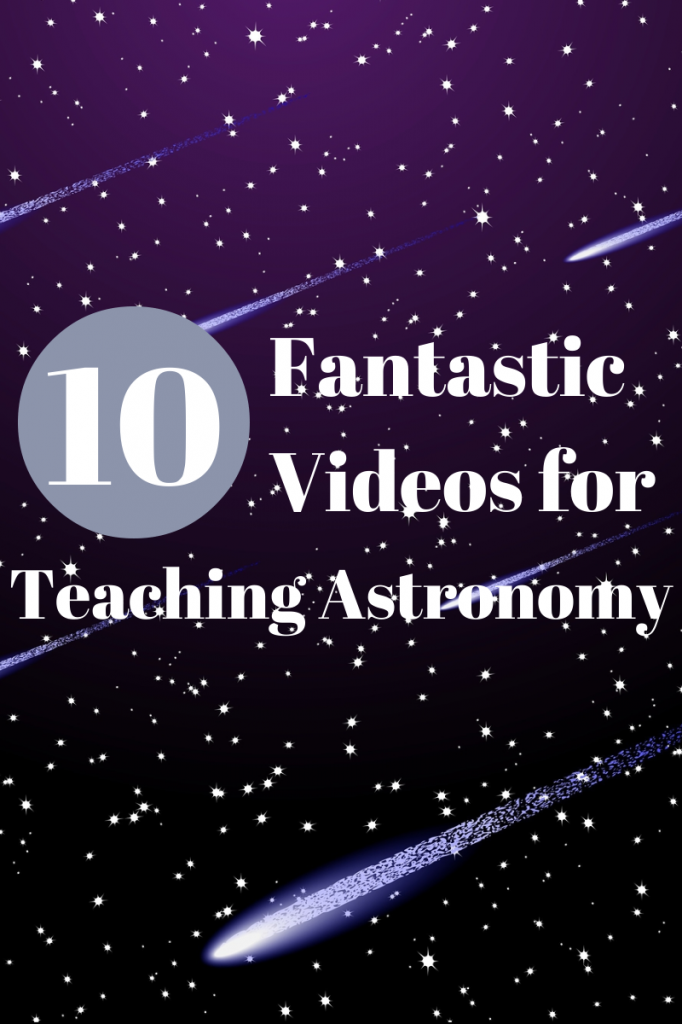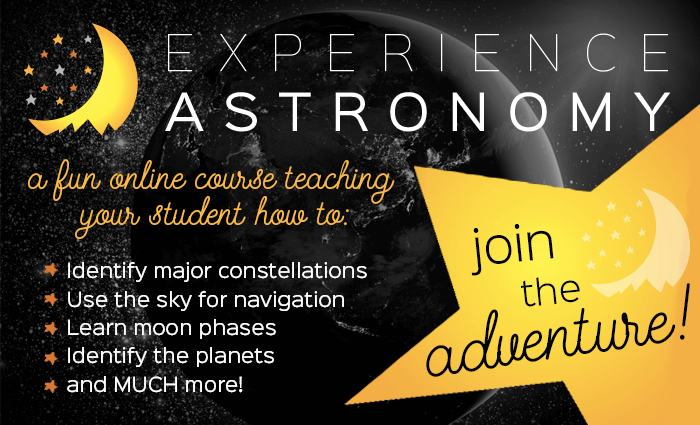Last year, in our homeschool co-op, I taught a group of high school students about classical astronomy. This year I switched to teaching grammar-level students. It has been so much fun watching little eyes light up as I show off pictures of our solar system.
Throughout the year I’ve shown many different astronomy videos. Here are the students’ favorite ones.
.
10. Revolving Around Polaris
As the earth rotates on its axis, the stars appear to move through the sky throughout the night. Notice, in the center of the screen is the North Star, which doesn’t appear to move as the night passes.
Quiz for your child: What is the North Star’s name and why doesn’t it move in the sky?
.
9. Auroras: The Northern and Southern Lights
“Aurora” is Latin for “sunrise.” Over both Northern and Southern magnetic poles, these natural light displays have inspired people for centuries. Note at the end of the video the view of an aurora from the International Space Station in orbit above the Earth.
Quiz for your child: What causes auroras to appear?
.
8. Lake Ontario on Titan
The moon Titan has liquid methane lakes—the only object in the solar system, other than Earth, where liquid lakes are confirmed to exist. This one, called “Ontario Lacus” (Lake Ontario), was observed by the NASA spacecraft Cassini.
Quiz for your child: Titan is the largest moon of what planet?
.
7. Lunar Eclipse
This is a time lapse video of the lunar eclipse that took place in December 2010. A lunar eclipse is the Earth’s shadow, cast by the sun, on the surface of the moon.
Quiz for your child: Why does the moon glow red during an eclipse?
.
6. Black Hole Swallows a Star
This is an artist’s rendition of what might happen if a star got too close to a black hole. Scientists believe a black hole could form after a massive star explodes in a supernova.
Quiz for your child: Why are black holes black?
.
5. Comet Collides with Jupiter
In July 1994, the world watched as a comet broke into many pieces and crashed into the planet Jupiter. The impacts could be seen from telescopes on Earth.
Quiz for your child: What are comets made of?
.
4. Meteorite Crashes on Mars
This fun video is a computer generated picture of what it might look like for a meteoroid to enter Mars’ atmosphere. The NASA-made moving science laboratory, Curiosity, looks on as the rock crashes on the ground.
Quiz for your child: What are the differences between a meteoroid, a meteor, and a meteorite?
.
3. Burn, Baby, Burn: The Power of Solar Lenses
This is conglomeration of videos I found online showing how magnifying glasses can focus the heat of the sun in one spot. (Kids, don’t try this at home.)
Quiz for your child: How far away is the sun? (Give the answer in miles or light-minutes.)
.
2. Singing Stars: How Great is Our God
In this sermon clip, Louie Giglio talks about a possible meaning of Psalm 148:3—perhaps the stars really are singing to God.
Quiz for your child: Some of these distant objects are thousands of light-years away. What is a light-year?
Watch a longer version of this video here.
.
1. Planets, Sun, and Stars: A Comparison of Sizes
This video was by far the favorite video of the year. It shows the relative sizes of planets, the sun, and other stars in our galaxy.
Quiz for your child: What kind of galaxy is our galaxy and what is its name?
.
Answers to Quiz Questions:
10. The North Star is called Polaris. It doesn’t move because our North Pole points right at it. (Picture standing under an umbrella, spinning it around. The center of the umbrella won’t appear to turn.)
9. Auroras are caused by solar wind interacting with energetic particles high in the atmosphere.
8. Titan is the largest moon of Saturn. It is larger than even the planet Mercury.
7. When the sun sets on Earth, often the horizon is red. If you were standing on the moon during a lunar eclipse, you would see the Earth completely covering the sun with a red, sunset glow around the rim of the whole Earth. This red light shines on the moon and is reflected back to us. (Here’s one artist’s rendition of what it might look like from the moon.)
6. Black holes have so much gravitational force (because they have so much mass) that not even light can escape them.
5. Comets are made of rock and ice.
4. A meteoroid is flying around in space. It becomes a meteor when it enters Earth’s atmosphere. It becomes a meteorite when it lands on the ground.
3. The sun is about 93 million miles away or about 8 light-minutes (the light from the sun takes 8 minutes to get to our eyes).
2. A light year is the distance light travels in a year (5,879,000,000,000 miles).
1. Our galaxy is a spiral galaxy. It is called the Milky Way.
Online Video Astronomy Course
If you want to go deeper in the subject of astronomy, let me do the teaching for you! I’ve designed a full-year online astronomy video course for students 12 years old and up. It is called Experience Astronomy. In the course, students learn how to find major constellations, how the sun, moon, and stars move, and how astronomy is applicable to daily life.
From March 8th to the 16th, register your child for 40% off. This is the rock bottom price. You will not see the price this low again before the course starts in September.





Thanks for the list! It looks great!
My husband used the Apologia astronomy to teach science at our homeschool co-op this year. He had SO much fun with it and the kids always enjoyed the videos he found to go along with the lessons 🙂
We watched them all tonight–so cool! Thanks again!
Thanks for sharing these! I’ll show them to my son later. I know he will enjoy them!
Found a good video from a Nasa Engineer – that Nasa won’t show.
http://www.youtube.com/watch?v=s9_o7NGTkJc&list=TL8i9o4MhLfqXGeAH7NsehDWTnagEFwgUT
ok trying to post again.
http://www.youtube.com/watch?v=s9_o7NGTkJc